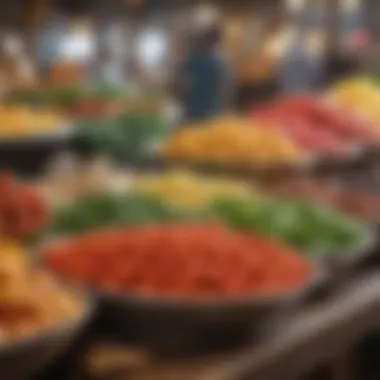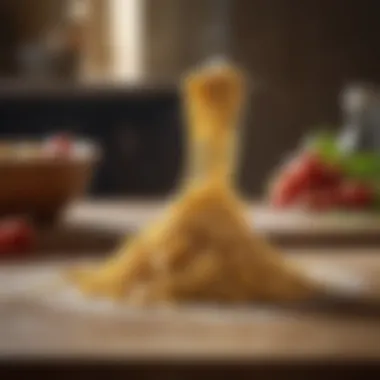Culinary Traditions of Venice: An In-Depth Exploration


Intro
Venice is more than just a city of canals and stunning architecture; it is a destination where culinary traditions intermingle with the rich history of Italy. The culinary scene here showcases a convergence of local ingredients and influences from various cultures, stemming from Venice’s historical role as a trade hub. This article navigates the culinary landscape of Venice, offering insights into its food culture and how it reflects the city’s vibrant history.
From intricate dishes to simple yet flavorful recipes, Venetian cuisine invites exploration. By understanding the foundational elements of this culinary tradition, one can appreciate not only the flavors but also the stories that accompany them.
Recipe Overview
Dish Description
Venetian cuisine is characterized by its unique dishes that often incorporate seafood, rice, and vegetables. A prime example is Risotto al Nero di Seppia, a black risotto made with cuttlefish and its ink, showcasing the intimate relationship between Venice and its surrounding waters. The dish is bold and memorable, exemplifying Venice’s flair for combining simplicity with depth of flavor.
Cuisine Type
This falls under Italian cuisine, yet it holds distinct flavors and techniques that set it apart from other regions. Venetian food is often slightly sweeter, a reflection of the influence from the spice trade and various cultures that have passed through the city.
Ingredients List
Detailed Ingredients
- Arborio rice
- Fresh cuttlefish
- Cuttlefish ink
- Onion
- White wine
- Fish broth
- Olive oil
- Parsley for garnish
Each ingredient plays a pivotal role in creating the characteristic flavor profile of the dish. Arborio rice provides a creamy texture, while the fresh cuttlefish adds freshness. The ink contributes a unique visual and taste dimension, essential for an authentic black risotto.
Substitutions and Variations
While the traditional recipe shines with cuttlefish, there are variations one might consider:
- Substitute cuttlefish with squid for a milder flavor.
- Use vegetable broth instead of fish broth for a vegetarian version.
- For a twist, add saffron for a fragrant and colorful variation.
The beauty of Venetian cuisine lies in its adaptability and the potential for creativity. Exploring these variations can bring new life to traditional recipes.
Important Insight: Understanding these foundational aspects of Venetian cuisine enhances the appreciation for each dish's cultural and historical significance.
As we further explore Venice’s culinary traditions, we will delve into key historical influences, essential cooking techniques, and the vibrant modern trends reshaping this remarkable cuisine.
Prolusion to Venetian Cuisine
Venetian cuisine reflects a rich cultural history, shaped by the unique geographical position of Venice in Italy. As a city that has seen a multitude of influences over centuries, the cuisine offers a diverse and tantalizing array of flavors. Understanding Venetian cuisine is crucial not only for food enthusiasts but also for those interested in cultural history and traditions. The aspects of culinary traditions in Venice reveal how local ingredients and historical interactions create distinctive dishes that are celebrated around the world.
Historical Influences
Venetian cuisine is deeply influenced by various historical elements, including trade routes and migration patterns. During the Middle Ages, Venice prospered as a trading hub connecting the East and West. This made the city a melting pot of flavors and cooking techniques. The trading of spices, spices and ingredients such as saffron, rice, and exotic fruits contributed to the richness of the local cuisine.
For centuries, the Venetian Republic established culinary exchanges with regions across the Mediterranean, creating unique dishes like Risotto al Nero di Seppia, characterized by cuttlefish ink, and Sarde in Saor, a marinated sardine dish. These dishes illustrate how historical context shapes contemporary taste, making it vital to explore the past to appreciate the present culinary landscape of Venice.
Cultural Significance
Beyond historical influences, Venetian cuisine is a vital aspect of the city’s cultural identity. Food in Venice is not merely for sustenance; it serves as a medium for socializing and community building. Shared meals, particularly during festivals and family gatherings, strengthen communal ties and offer insights into traditional customs.
Moreover, local culinary practices emphasize the importance of seasonality and the use of fresh ingredients, which speak to the Italian ethos of cooking with respect to nature.
"In Venice, food is an art form that evolves yet remains anchored in tradition."


As such, Venetian cuisine works not only as a representation of geographical influences, but also as a canvas showcasing the vibrant culture and traditions cherished by the locals. This understanding of cultural significance enriches one's appreciation for the culinary offerings that define Venice today.
Key Ingredients in Venetian Cooking
The foundation of Venetian cuisine lies in its key ingredients, which reflect the region's geography, culture, and history. These elements are crucial, as they contribute to the distinctive flavors and textures found in Venetian dishes. Understanding the intrinsic role of each ingredient helps food lovers appreciate the richness of Venetian gastronomy.
Fresh Seafood Variety
Venice's location alongside the Adriatic Sea grants it access to a bountiful selection of seafood. The local waters host a diverse array of fish and shellfish, such as shrimp, clams, and squid. This variety plays a significant role in the culinary landscape of Venice. The proximity to the sea ensures that seafood is always fresh and a central component of many traditional recipes.
The use of seafood extends beyond just main courses. For instance, Risotto al Nero di Seppia, which features cuttlefish ink, exemplifies how seafood can provide a unique twist to a classic dish. Additionally, local markets like the famous Rialto Market provide chefs and home cooks with the freshest catches, further emphasizing the importance of sourcing quality, local ingredients.
Local Vegetables and Herbs
Venetian cuisine is also characterized by its rich selection of local vegetables and aromatic herbs. Produce such as artichokes, radicchio, and asparagus thrive in the fertile lands surrounding Venice. These ingredients add freshness, color, and flavor to various dishes, making them essential in seasonal cooking.
Herbs like parsley, basil, and rosemary enhance the profiles of many traditional recipes. The emphasis on local and seasonal ingredients demonstrates the Venetian approach to cooking, which is rooted in traditions that prioritize quality and sustainability. Many Venetian dishes, such as Sarde in Saor, rely on local vegetables to provide balance and depth.
Cheeses and Frozen Delicacies
Cheese is another indispensable element of Venetian cooking. Varieties like Asiago and Montasio are popular choices. These cheeses not only complement various dishes but also serve as rich, creamy bases for sauces. The connection between cheese and local dairy farming adds another layer to the understanding of Venetian ingredients.
Additionally, frozen delicacies like Baccalà Mantecato highlight the Venetian tradition of preserving ingredients. Dried cod, for instance, undergoes a transformation into a creamy spread, showcasing the creativity in utilizing what might otherwise be overlooked. This preservation technique has historical roots, allowing it to be utilized throughout the year.
Breads and Pastries
Breads and pastries form a vital part of the Venetian culinary landscape. Local bread, such as ciabatta, is well-known for its crusty exterior and soft interior. It serves as an excellent accompaniment to many dishes, providing not just sustenance but also texture.
Pastries, too, hold a special place in Venetian culture. Frittelle, typically enjoyed during Carnival, reflect the sweet side of Venetian cuisine. These deep-fried delights often feature raisins or cream, and their popularity hints at the broader Italian tradition of celebratory foods. Such pastries are frequently made with local ingredients, further solidifying their importance in Venetian cooking.
By exploring these key ingredients, one gains insight into the authentic flavors that define Venetian cuisine. Each component tells a story of place, tradition, and creativity, making them integral to the culinary identity of Venice.
Traditional Venetian Dishes
Traditional Venetian dishes represent a significant component of the city’s culinary heritage. These dishes encapsulate the rich history and diverse influences that have shaped Venetian cuisine over centuries. Each dish tells a story of local ingredients, historical events, and the influence of various peoples who have inhabited the region. Understanding these dishes is crucial as they provide insight into the Venetian way of life, revealing how food is both a reflection of culture and a means of expression.
Risotto al Nero di Seppia
Risotto al Nero di Seppia is a hallmark of Venetian cuisine. This dish features arborio rice cooked with cuttlefish and enriched with its ink, giving it a distinct black color and a complex flavor profile. The preparation of this dish requires careful timing and technique. The rice must be stirred continuously to achieve the ideal creaminess. This dish is not merely sustenance; it represents the connection between Venetian people and their maritime environment. Often served in local trattorias, it is a beloved staple that visitors seek out to experience the authentic taste of Venice. The choice of cuttlefish as a primary ingredient underscores the Venetian reliance on fresh seafood, showcasing how this dish is a product of local fishing traditions.
Sarde in Saor
Sarde in Saor exemplifies the Venetian ability to blend sweet and sour flavors. This preservation method involves marinated sardines, typically layered with onions, pine nuts, and raisins, then seasoned with vinegar and spices. The dish has roots that trace back to historic trade practices, which brought spices from distant lands. Traditionally served as an antipasto, Sarde in Saor not only highlights local sardines but also embodies the Venetian skill in heightening flavors through careful seasoning. This dish is a testament to the city's resourcefulness, allowing the use of readily available ingredients to create something remarkable.
Baccalà Mantecato
Baccalà Mantecato is a creamy whipped cod dish that highlights another important element of Venetian cuisine. The cod is soaked and rehydrated, then blended with olive oil, garlic, and sometimes mayonnaise to create a smooth spread. Served on crostini or polenta, this dish is a traditional part of Venetian festivities as well as everyday dining. Its creamy texture and rich flavor make it a favorite among locals. Baccalà Mantecato illustrates the use of preserved fish in Venetian cooking, reflecting both the maritime traditions and the resourceful adaptations made over time.
Cicchetti
Cicchetti are small plates or snacks served in Venetian bars known as bacari. These bites vary widely, including options like meatballs, marinated vegetables, and seafood. Cicchetti embody the communal spirit of Venetian dining, encouraging sharing and socializing among friends and family. The range of flavors and preparations available in cicchetti allows for exploration and enjoyment of multiple tastes in one meal. This culinary tradition not only emphasizes the importance of community but also showcases the creativity of Venetian chefs in utilizing diverse local ingredients.
Tiramisu di Venezia


Tiramisu di Venezia is a variation of the classic Italian dessert that originates from this unique city. This version often runs with local ingredients and flavors, such as adding zabaglione made with local wine. The delightful combination of mascarpone, coffee, and cocoa makes this dessert irresistible. Each bite transports you to the heart of Venice, highlighting quintessential elements of its culture and taste. Tiramisu exemplifies how dessert can be an experience, marking special occasions, holidays, and family gatherings.
"To truly understand a culture, one must indulge in its food. Venice's dishes reflect its identity and its history."
These traditional Venetian dishes form the backbone of the city’s culinary landscape. They not only nourish but also tell a story of resilience, creativity, and connection to the sea and land.
Dining Etiquette in Venice
Understanding dining etiquette is essential when experiencing Venetian cuisine. It goes beyond mere manners; it encompasses the culture and rich traditions of the city. Observing etiquette adds layers to the culinary experience, enhancing one’s appreciation for the meal and the setting. In Venice, meals are regarded as social events, integrating food with festivity and camaraderie. It is beneficial to be aware of local customs to ensure a respectful and enjoyable interaction with Venetian dining practices.
Understanding the Meal Structure
In Venice, meals are typically structured and can be divided into four main parts: antipasti, primi, secondi, and dolci. Antipasti serves as the appetizer, setting the tone for the meal. A variety of small dishes may be presented, allowing diners to sample different flavors.
Next comes primi, which consists of pasta or risotto. This course is significant, as it often showcases local ingredients and cooking techniques. The secondi follows, featuring protein dishes. Popular choices include fish or meat, reflecting Venice's rich seafood heritage. Finally, the meal concludes with dolci, or desserts, often highlighting sweet creations unique to the region.
This progression not only emphasizes the different components of Venetian cuisine but also allows diners to savor each portion without feeling rushed. Each course is designed to be enjoyed, fostering conversation and connection among diners. Understanding this structure makes it easier for newcomers to engage properly and fully appreciate their dining experience.
Local Customs and Practices
Venetian dining customs reflect the city’s history and its residents’ values. One notable custom is the timing of meals. Dinner is usually served late, often around 8 or 9 PM, which may be different from many other cultures. Hence, adjustments in expectations are necessary for visitors.
Additionally, the practice of sharing dishes, especially during cicchetti, encourages communal dining. These small plates are meant to be passed around, creating an atmosphere of sharing and togetherness. This custom not only promotes friendship but also allows for a wider sampling of flavors.
When dining in public establishments, such as bacari, it is common to order food and drinks separately. This practice can be surprising for some tourists. It is advisable to also note the style of payment preferred by the restaurant, as some may only accept cash.
"Dining in Venice is as much about the experience as the food. By following local customs, one can enjoy a richer culinary journey."
In summary, dining etiquette in Venice is crucial for those wishing to engage with the culture sincerely. In understanding the meal structure and local practices, visitors can find themselves more connected to the experience, ultimately leading to a deeper appreciation of Venetian culinary traditions.
Contemporary Trends in Venetian Cuisine
Venetian cuisine, rich in tradition, continues to evolve. Modern influences shape its current expression. Understanding these contemporary trends is essential for appreciating how historical roots can adapt to modern preferences.
Fusion Cuisine Innovations
Fusion cuisine represents a blend of global culinary practices. In Venice, chefs experiment with local ingredients while integrating unique elements from other cultures. For example, a dish may combine classic seafood with spices from Asia.
This approach broadens the gastronomic experience. Diners can enjoy familiar flavors enhanced by unexpected twists.
- Chefs focus on creativity while respecting local traditions.
- Popular examples include risottos with exotic flavors or cicchetti that incorporate international ingredients.
Fusion cuisine also encourages culinary dialogue, creating a vibrant exchange of ideas. Chefs collaborate, learning and innovating together.
Sustainability in Food Sourcing
Sustainability has become a guiding principle in Venetian kitchens. As the global food supply chain faces scrutiny, many chefs emphasize local and sustainable sources.
Venice, surrounded by rich marine life and fertile land, has access to ingredients that can support this trend. Farmers and fishers work together to ensure fresher options that benefit the environment.
Several aspects characterize this shift:
- Local Harvests: Ingredients sourced from the nearby lagoon and countryside enhance freshness.
- Ethical Fishing Practices: Awareness of overfishing leads to sustainable seafood initiatives.


This trend not only satisfies environmental considerations but also enriches the dining experience. Diners appreciate meals that are both tasty and conscientious.
Rising Popularity of Plant-Based Dishes
In recent years, there has been a significant increase in plant-based options within Venetian cuisine. This reflects a broader global shift towards healthier living.
Chefs explore vegetable-focused dishes, often highlighting the bounty of the region. Classic recipes are reimagined to emphasize seasonal vegetables and grains.
Some notable aspects include:
- Creative Preparations: Traditional dishes may be adapted using plant-based substitutes, showing versatility.
- Health-Conscious Ingredients: Salads, vegetable risottos, and plant-based cicchetti cater to growing dietary preferences.
As awareness about personal health and environmental impact grows, diners increasingly seek out these options, influencing restaurant menus across the city.
"The culinary landscape of Venice is shifting, reflecting modern values while honoring its rich heritage."
Overall, contemporary trends in Venetian cuisine highlight a dynamic interplay between tradition and modernity. By embracing fusion, sustainability, and plant-based innovations, Venice remains a pivotal player in the evolving narrative of global gastronomy.
Venetian Influences on Global Cuisine
The culinary traditions of Venice extend beyond its borders. With its history of trade and cultural exchanges, Venice has influenced global cuisine significantly. Identifying and understanding these influences is essential to appreciate the depth of Venetian culinary practices and how they have shaped eating habits around the world. The fusion of flavors and techniques from different regions has allowed Venetian cuisine to evolve, impacting myriad dishes and practices worldwide.
Culinary Exchanges with Other Regions
Venice's strategic location has always been a crossroads for various cultures. This position facilitated exchanges with the East, fostering a unique blend of spices and ingredients that became integral to Venetian cooking. For instance, spices like saffron and cinnamon made their way into the dishes of Venice through trade routes with the Middle East.
The importation of ingredients like rice and citrus fruits, primarily from Asia and North Africa, greatly influenced traditional Venetian recipes. Today, many global dishes owe their existence to this era of culinary exchange, showcasing how Venetian flavors can blend seamlessly with those from other cultures.
- Saffron Risotto incorporates Persian influence, demonstrating how Venetian cuisine adopted foreign ingredients to create something unique.
- Sweet and Sour Dishes, often including vinegar and sugar, have origins that can be traced to early Venetian kitchens influenced by Byzantine culinary methods.
These exchanges illustrate not just adaptation but also the rich, multilayered fabric of Venetian culinary heritage. An appreciation of this history enhances one’s understanding of how local cuisine reflects broader global interactions.
Incorporation of Venetian Techniques Abroad
As Venetian chefs traveled, they took their skills and techniques with them, planting the seeds for culinary traditions in other regions. Techniques such as the careful preparation of seafood, the slow cooking of risottos, and the discipline of making fresh pasta have resonated in kitchens far from Italy.
Notable examples include:
- Influence on Mediterranean Cuisine: Many Mediterranean countries have adopted Venetian cooking techniques, particularly in seafood preparation. The emphasis on freshness and simplicity aligns with their climates and cultures, fostering a similar culinary ethos.
- Culinary Schools: Institutions inspired by Venetian cooking appear worldwide, teaching the delicate balance of flavors that define this cuisine. The art of layering tastes and textures continues to shape the culinary landscape globally.
"Culinary traditions are not static; they evolve as they interact with new cultures and environments, reflecting a dynamic history rich with possibilities." - Unknown
By recognizing these influences, food enthusiasts can appreciate the broader narrative of culinary arts, deepening their connection to diverse global flavors.
Culmination: Preserving Venetian Culinary Heritage
The importance of preserving Venetian culinary heritage cannot be overstated. Venice is not merely a tourist destination known for its canals and architecture; it is a hub of culinary traditions that reflect its rich history and diverse cultural influences. Authenticity in cooking has become increasingly vital as globalization permeates food practices. Preserving Venetian culinary practices ensures that recipes passed down through generations remain intact and appreciated for their uniqueness. This can contribute positively not only to the local economy through tourism but also enrich the cultural identity of Venice itself.
Importance of Authenticity in Cooking
Authenticity in Venetian cooking begins with a commitment to using traditional recipes and local ingredients. It embodies the flavors, techniques, and histories of the region. With the rise of fusion cuisines and culinary globalization, the true essence of Venetian dishes can sometimes be lost. By focusing on authentic preparation methods, eateries contribute to a stronger culinary identity. This results not only in better dishes but also in a deeper experience for those who visit restaurants or homes serving traditional cuisine. Here are some reasons why authenticity matters:
- Cultural Preservation: Maintaining traditional cooking methods supports the culture and history of a place.
- Quality of Ingredients: Using local produce and seafood enhances the flavor and nutritional value of the dishes.
- Tourism Appeal: Authentic experiences can attract tourists seeking genuine cultural interactions through cuisine.
The Role of Education in Culinary Arts
Educational programs in culinary arts play a crucial role in ensuring the preservation and evolution of Venetian cuisine. Institutions that focus on teaching traditional methods provide a pathway for aspiring chefs to learn about the importance of regional ingredients and cooking techniques. They help foster an appreciation for local culinary heritage while also encouraging innovation within those boundaries. The role of education includes:
- Skill Development: Training chefs to master traditional dishes ensures that skill levels remain high, maintaining quality.
- Innovation: While preserving tradition, education also encourages creativity that aligns with modern tastes, thus attracting a wider audience.
- Community Engagement: Engaging local communities in culinary education can promote interest among younger generations, ensuring longevity of traditions.







